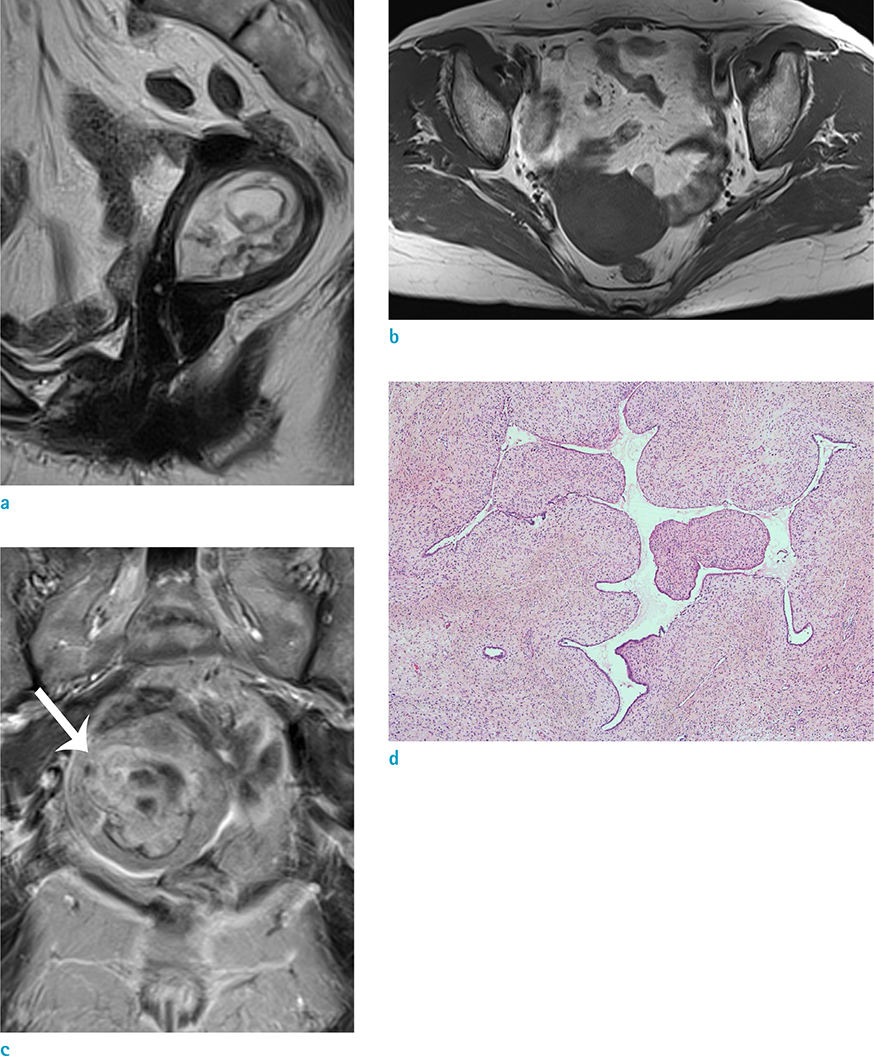Investig Magn Reson Imaging.
2015 Mar;19(1):56-61. 10.13104/imri.2015.19.1.56.
MR Imaging Findings of Tamoxifen-associated Uterine Adenosarcoma: Report of Two Cases
- Affiliations
-
- 1Department of Radiology, Anam Hospital, College of Medicine, Korea University, Seoul, Korea. urorad@korea.ac.kr
- KMID: 2175578
- DOI: http://doi.org/10.13104/imri.2015.19.1.56
Abstract
- Adenosarcoma of the uterus is a rare biphasic tumor containing benign glandular epithelial and malignant mesenchymal components. The tumor has been reported to be associated with antiestrogen therapy, particularly tamoxifen, but there have been a few case reports with MRI. We present two cases of MRI findings of uterine adenosarcoma after antiestrogen therapy, tamoxifen and toremifene in breast cancer patients. The tumor presents as a large polypoid mass occupying the endometrial cavity, and may protrude into the vagina. On MRI, the tumor typically shows solid components with scattered small cysts and heterogeneous enhancement. These findings are not significantly different from conventional adenosarcoma.
Keyword
MeSH Terms
Figure
Reference
-
1. Clement PB, Scully RE. Mullerian adenosarcoma of the uterus: a clinicopathologic analysis of 100 cases with a review of the literature. Hum Pathol. 1990; 21:363–381.2. Chourmouzi D, Boulogianni G, Zarampoukas T, Drevelengas A. Sonography and MRI of tamoxifen-associated müllerian adenosarcoma of the uterus. AJR Am J Roentgenol. 2003; 181:1673–1675.3. Yoshizako T, Wada A, Kitagaki H, Ishikawa N, Miyazaki K. MR imaging of uterine adenosarcoma: case report and literature review. Magn Reson Med Sci. 2011; 10:251–254.4. Lee HK, Kim SH, Cho JY, Yeon KM. Uterine adenofibroma and adenosarcoma: CT and MR findings. J Comput Assist Tomogr. 1998; 22:314–316.5. Soh E, Eleti A, Jimenez-Linan M, Arends M, Latimer J, Sala E. Magnetic resonance imaging findings of tamoxifen-associated uterine Mullerian adenosarcoma: a case report. Acta Radiol. 2008; 49:848–851.6. Takeuchi M, Matsuzaki K, Yoshida S, et al. Adenosarcoma of the uterus: magnetic resonance imaging characteristics. Clin Imaging. 2009; 33:244–247.7. Chi F, Wu R, Zeng Y, Xing R, Liu Y, Xu Z. Effects of toremifene versus tamoxifen on breast cancer patients: a meta-analysis. Breast Cancer. 2013; 20:111–122.8. Clement PB. Müllerian adenosarcomas of the uterus with sarcomatous overgrowth. A clinicopathological analysis of 10 cases. Am J Surg Pathol. 1989; 13:28–38.9. Nalaboff KM, Pellerito JS, Ben-Levi E. Imaging the endometrium: disease and normal variants. Radiographics. 2001; 21:1409–1424.10. Shah SH, Jagannathan JP, Krajewski K, O'Regan KN, George S, Ramaiya NH. Uterine sarcomas: then and now. AJR Am J Roentgenol. 2012; 199:213–223.
- Full Text Links
- Actions
-
Cited
- CITED
-
- Close
- Share
- Similar articles
-
- Endometrial mullerian adenosarcoma after toremifene treatment in breast cancer patients: a case report
- MR Findings of Extrauterine Mullerian Adenosarcoma Associated with Deep Pelvic Endometriosis
- A Case of Mullerian Adenosarcoma of the Uterine Corpus
- A Case of Solitary Brain Metastasis from Uterine Mullerian Adenosarcoma with Sarcomatous Overgrowth
- A Case of Mllerian adenosarcoma of vaginal stump after total abdominal hysterectomy



